Trucking Accidents in Virginia
Breit Biniazan—March 31, 2022
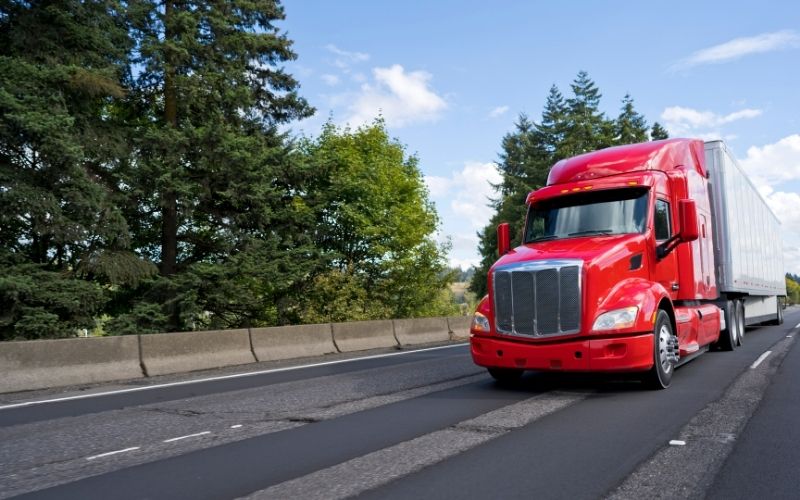
Trucking is big business in every sense of the word. The industry accounts for 70% of all US shipping and generates $700 billion in revenue annually1. Nearly 8 million people are employed by the industry, including 3.5 million drivers. But unfortunately, this big industry also has big consequences.
In 2018, there were nearly 500,000 crashes involving large trucks in the US2, 4,451 of which were fatal. Eighty-two percent of those deaths were not the truck drivers themselves, but passengers and drivers in other cars involved. The World Health Organization estimates that all road traffic accidents are the eighth leading cause of deaths worldwide.
In Virginia, trucking crashes are on the rise. There were 11,976 crashes involving a large truck in Virginia between 2016 and 20204. Because of a variety of factors—from increased online shopping and shipping to changes in driving habits because of COVID-19—experts estimate trucking accidents in Virginia will only continue to increase.
In Virginia, trucking crashes are on the rise.
In order to change these statistics, we must first understand the data behind them and their causes.
In order to change these statistics, we must first understand the data behind them and their causes. This study is intended to provide both the general public and those in the trucking industry with crash data and causes in Virginia.
In order to gather this information, we interviewed experts from organizations such as the Insurance Institute for Highway Safety and the Virginia Trucking Association and drew data from official sources such as the Virginia DMV and the Federal Motor Carrier Safety Administration. Together, this forms a study with a comprehensive set of data and abstract information equally applicable to a variety of researchers.
Citizens can use this study to cultivate awareness and stay safer. Public officials can cite the data for policy changes. Lawyers can use this information to protect their clients and bring them justice in court. In doing so, we hope to change the future of trucking in Virginia for the better.
Contents
- Part I: Number of Trucking Accidents in Virginia Statistics
- Part II: Trucking Accidents in Virginia by Location
- Part III: Trucking Accidents in Virginia by Time, Day, & Season
- Part IV: Causes of Trucking Accidents in Virginia
- Part V: Results and Injuries
- Part VI: Preventing Trucking Accidents in Virginia
- About Breit Biniazan
- References
Part I: Number of Trucking Accidents in Virginia Statistics
Every day, large trucks, passenger cars, and pedestrians are involved in accidents on Virginia’s highways and streets. Known as a “Large Truck Involved Crash,” this is any crash that involves at least one driver of a large truck (tractor trailer, semi, or double).
With more trucks on the road, these crashes are on the rise.
- In 2010, there were 1,971 accidents involving trucks on Virginia’s roads.
- Comparatively, in 2018—the year with the largest number of Virginia trucking crashes to date—there were 2,540 such accidents5.
- That’s an increase of nearly 30% over just eight years.
The rise in the number of trucking accidents in Virginia isn’t the only matter of concern. The rise in the number of fatal trucking accidents in the state is particularly worrisome.
“One of the more troubling things we’re seeing, both nationally and in Virginia, is that over the past decade, the number of crash deaths involving a large trucks has increased much more than the number of crash deaths not involving a truck,” says Eric Teoh, director of statistical services at the Insurance Institute for Highway Safety.
“Nationally, there’s been a 21% increase for truck-involved [fatalities] versus a 9% increase [in non-truck-involved fatalities]. And in Virginia, that’s 25% versus 11%,” Teoh explains.
The increase in fatalities in Virginia trucking accidents is drastically increasing when compared to accidents involving passenger cars alone.
Key Findings
- There were 23,817 crashes involving large trucks in Virginia from 2010 through 20205.
- Those crashes resulted in 549 fatalities5.
- Trucking accident fatalities in Virginia increased significantly in 2020 to 65 (a 25% increase from 2019)4.
Most trucking accidents in Virginia involve multiple cars (78% between 2016 and 2020)4.
Number of Trucking Accidents in Virginia
The data regarding the number of trucking accidents annually in Virginia indicates a gradual but steady increase in these crashes every year. The most recent data indicates there were some 2,356 trucking crashes involving trucks in 20204, which further bolsters this trend of 2,000+ such accidents annually in Virginia.
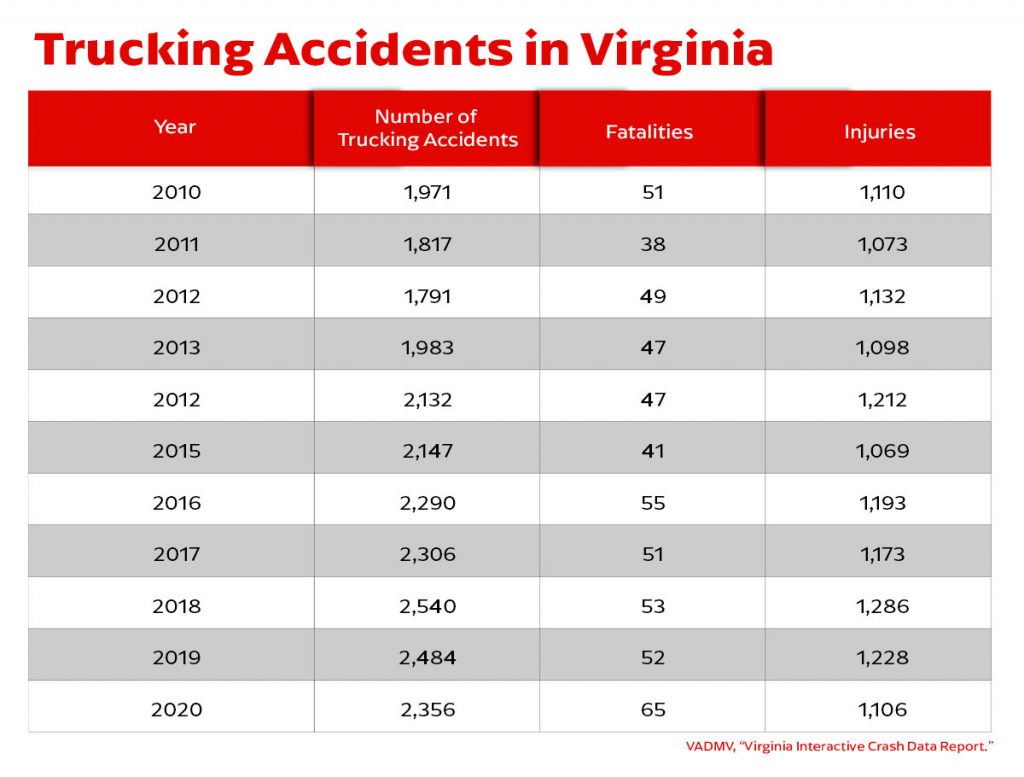
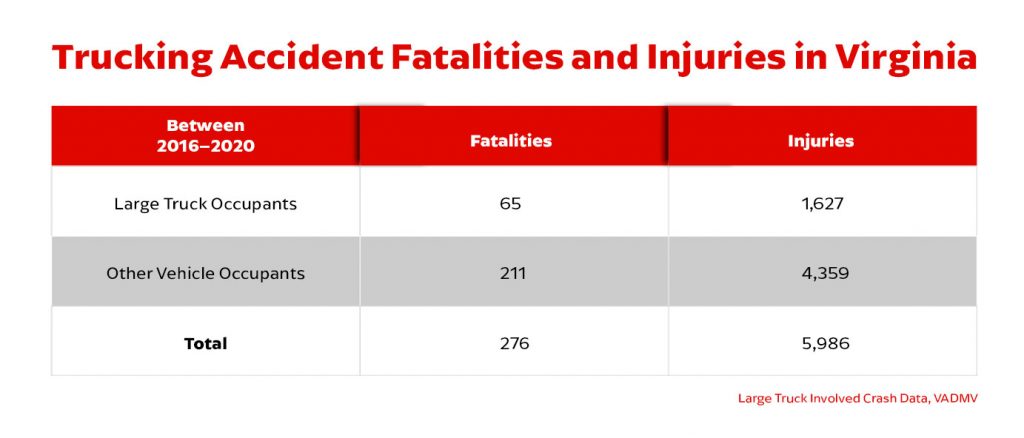
Experts like Teoh theorize that the increase in trucking accidents nationwide and in Virginia may be attributable to a number of factors. Among them are economic prosperity and an increase in shopping and shipping, which brings more cars to the road. The increase in speed limits and speeding may also be contributing to the rise in trucking crashes.
Number of Trucking Accident Fatalities in Virginia
As Eric Teoh of the Insurance Institute for Highway Safety pointed out, the most troubling statistic around the increase in trucking accidents is the correlative increase in fatalities. In 2011, there were only 38 trucking fatalities in Virginia5. Fatalities in 2020 skyrocketed to 654. That indicates an increase in fatalities of nearly 80%.
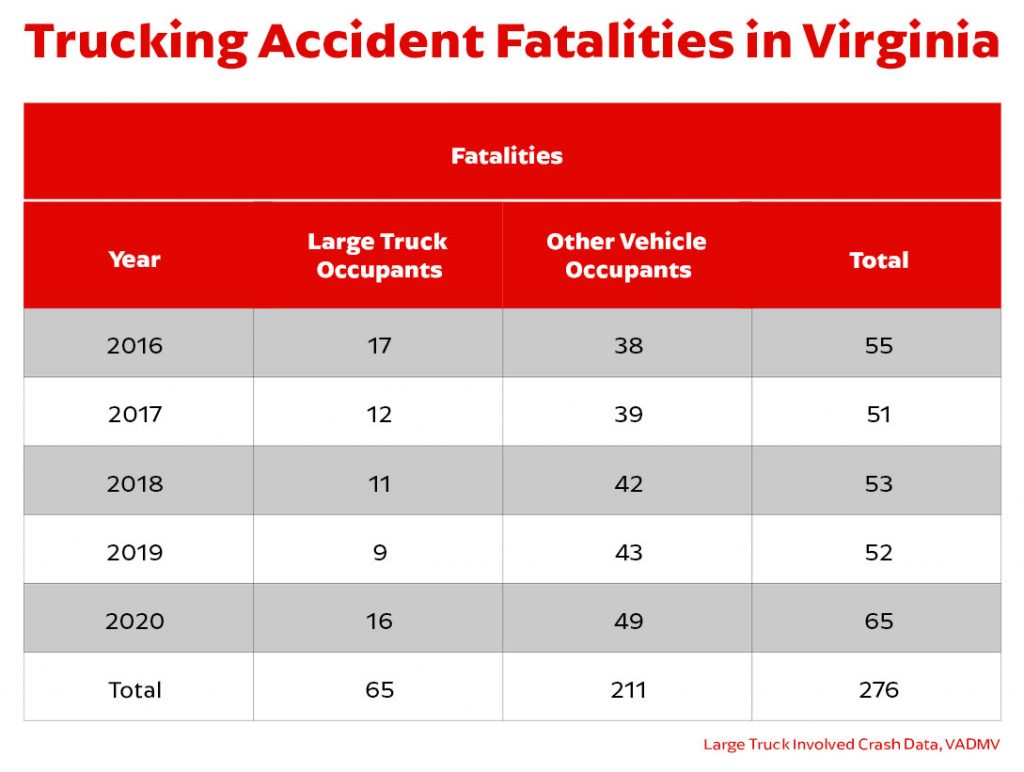
Teoh admits that experts don’t yet fully understand the reasons for this increase in fatalities.
He theorizes, “Passenger vehicles themselves have gotten a lot safer, but when you hit a truck, maybe that’s more than the safety structures can handle.” He also points out that these increases could be the “dark side of an improving economy” or attributable to increases in speeding.
Number of Trucking Accident Injuries in Virginia
Whereas the number of trucking accidents and their resulting fatalities may be on the rise, the number of injuries resulting from these injuries has been consistent in recent years. At first glance, this is an encouraging statistic.
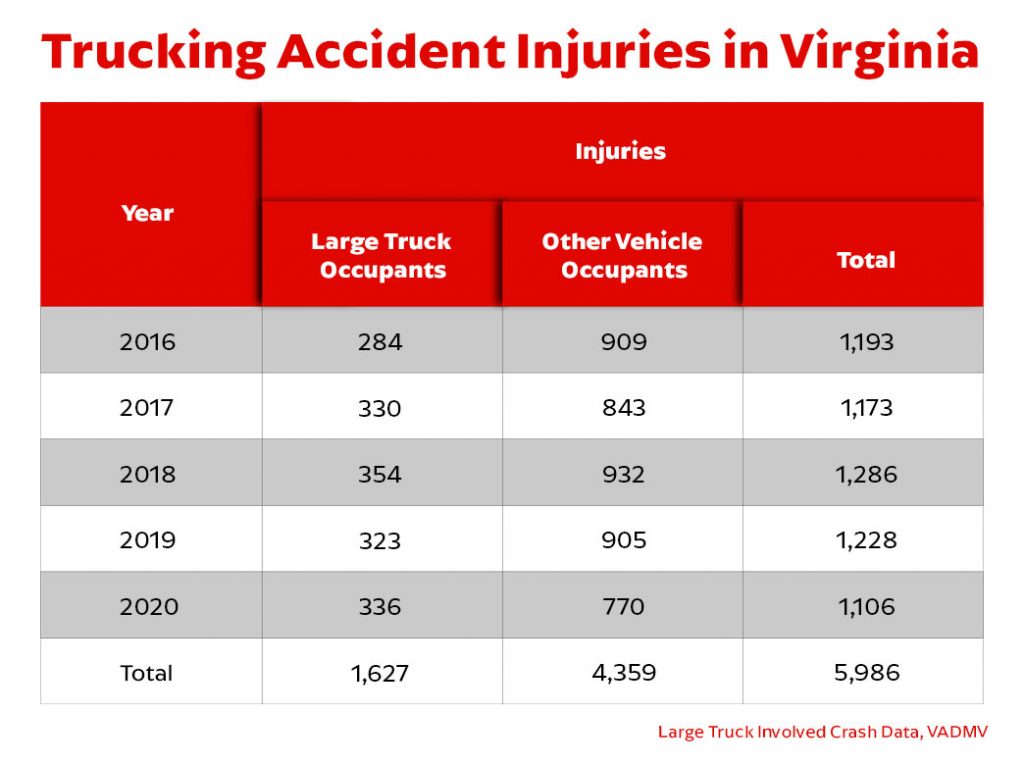
However, the consistency in the number of trucking accident injuries may correlate to the increase in fatalities.
“Large trucks are huge, so injuries do tend to be more severe or fatal,” says Teoh. It is possible that trucking accidents that are serious enough to cause injury may instead result in fatalities.
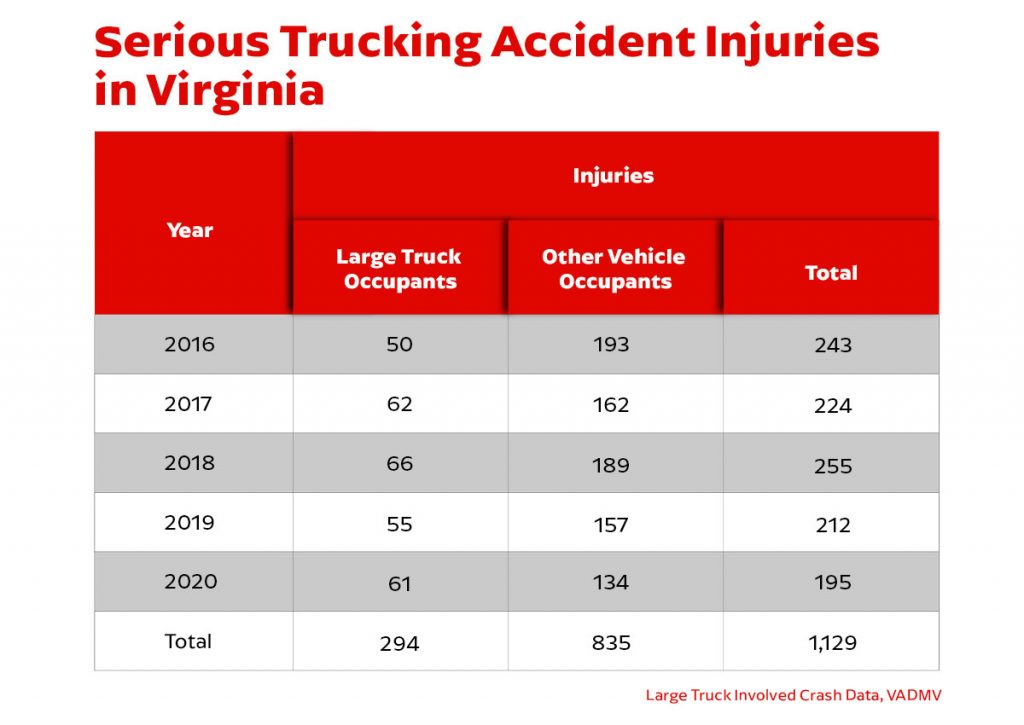
Multi-Vehicle and Single-Vehicle Trucking Accidents in Virginia
The majority of crashes involving large trucks do involve multiple vehicles. Data also indicates that multi-vehicle crashes involving trucks can be more deadly for passenger vehicle occupants.
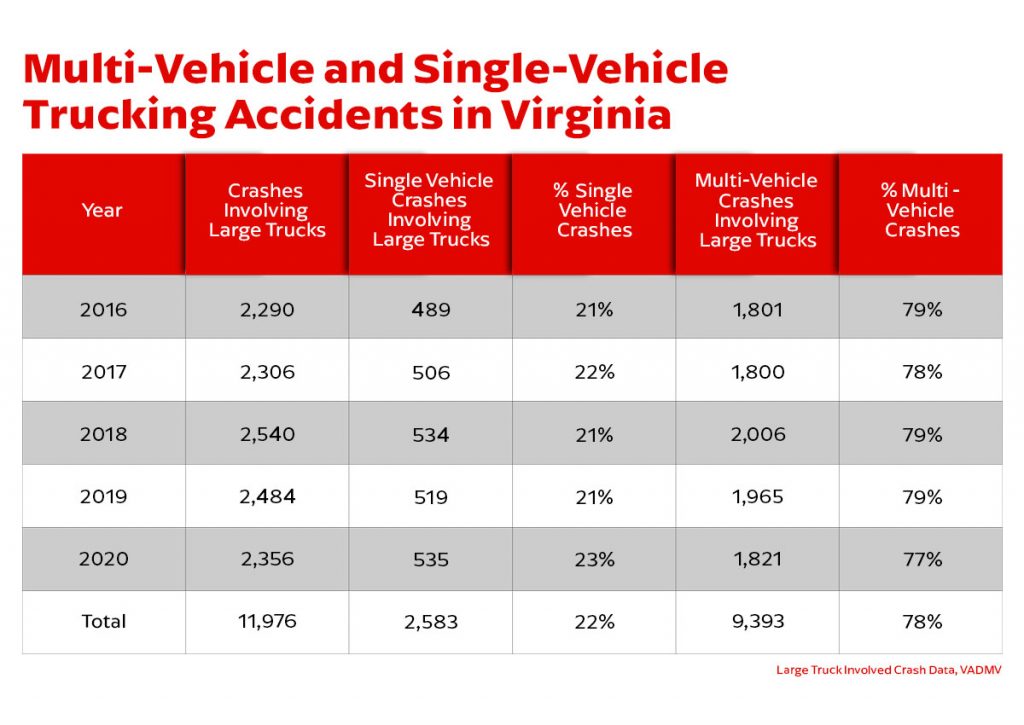
However, some studies show that single-vehicle trucking accidents may be more fatal than multi-vehicle crashes for truck drivers. According to the Insurance Institute for Highway Safety, in 2019, 55% of large truck occupant deaths nationwide occurred in single-vehicle accidents6.
Part II: Trucking Accidents in Virginia by Location
There are clear patterns regarding the location of trucking accidents in Virginia. As Eric Teoh of the Insurance Institute for Highway Safety points out, “Trucking crashes tend to occur where trucking traffic tends to occur, which is largely interstate and other non-interstate major roads.”
According to the DMV’s Virginia Highway Safety Office, “Crashes on interstates have increased 12%. From 2016 to 2020, 56% [of trucking accidents] were interstate crashes4.” Conversely, they say, “Non-interstate crashes have decreased.” The crashes in that time period occurred primarily on three major interstates in Virginia: I-64, I-81, and I-954.
When considering crash data across Virginia’s jurisdictions, areas with high numbers of trucking crashes correlate to areas with interstates. However, the problem of trucking accidents in Virginia is widespread. Of Virginia’s 133 jurisdictions, 131 had at least one large truck crash from 2016 to 2020.
Understanding the patterns of crashes in Virginia can help drivers of trucks and passenger vehicles alike cultivate awareness around high-crash areas. By driving more safely, especially following speed limits, in these areas, drivers may be able to decrease the likelihood of a crash.
Key Findings
- 131 of Virginia’s 133 jurisdictions had a large truck crash between 2016 and 20204.
- From 2016 to 2020, 56% of trucking crashes in Virginia occurred on interstates4.
- Of those interstate crashes, 77% occurred on I-64, I-81, and I-954.
- From 2016 to 2020, trucking crashes on I-95 increased by 27%4.
- At 872, Fairfax County had the highest number of truck-involved crashes between 2016 and 20204.
Trucking Accidents on Virginia Major Roads, Highways and Interstates
Trucking accidents occur most frequently on major roads, highways, and interstates. That is because these are the major thruways for trucks carrying and delivering loads across states and the country.
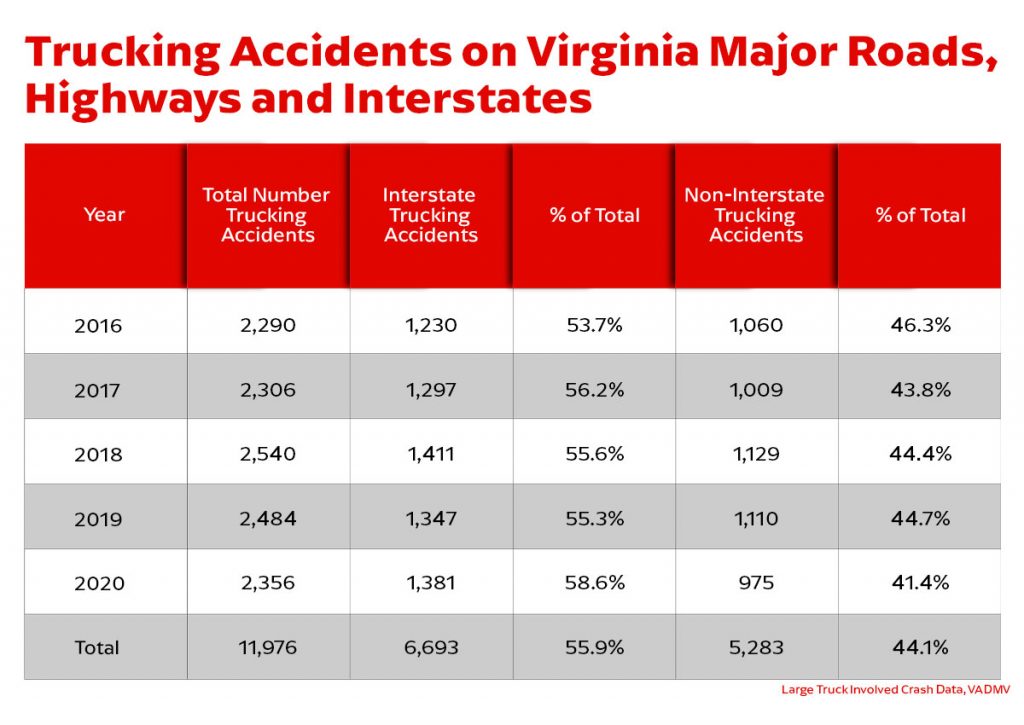
According to the Insurance Institute for Highway Safety, in 2019, 51% of deaths in truck accidents nationwide occurred on major roads (not interstates and freeways), 34% on interstates and freeways, and 15% on minor roads6. These trends are echoed in Virginia, where 56% of truck crashes from 2016 to 2020 occurred on interstates.
Interstate Crash Totals (Per Interstate):
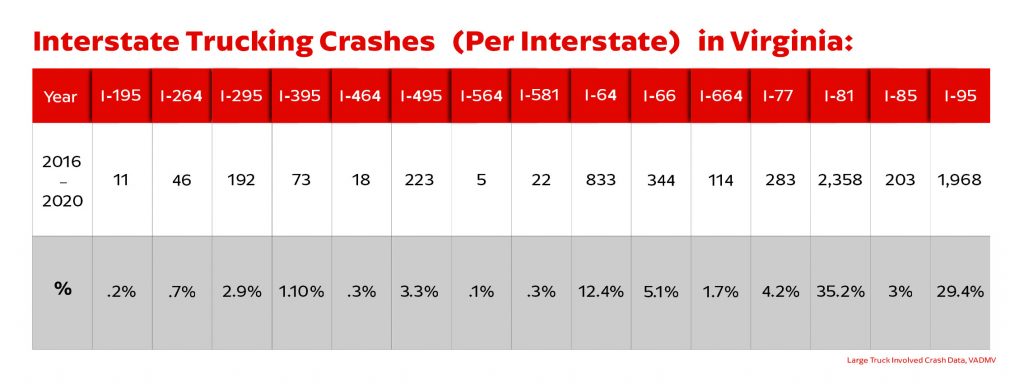
Trucking Accidents in Virginia Counties
Almost all of Virginia’s counties had trucking accidents between 2016 and 2020. Of the 133 jurisdictions in Virginia (which includes 95 counties and 38 independent cities), 131 had large truck accidents in this time period4.
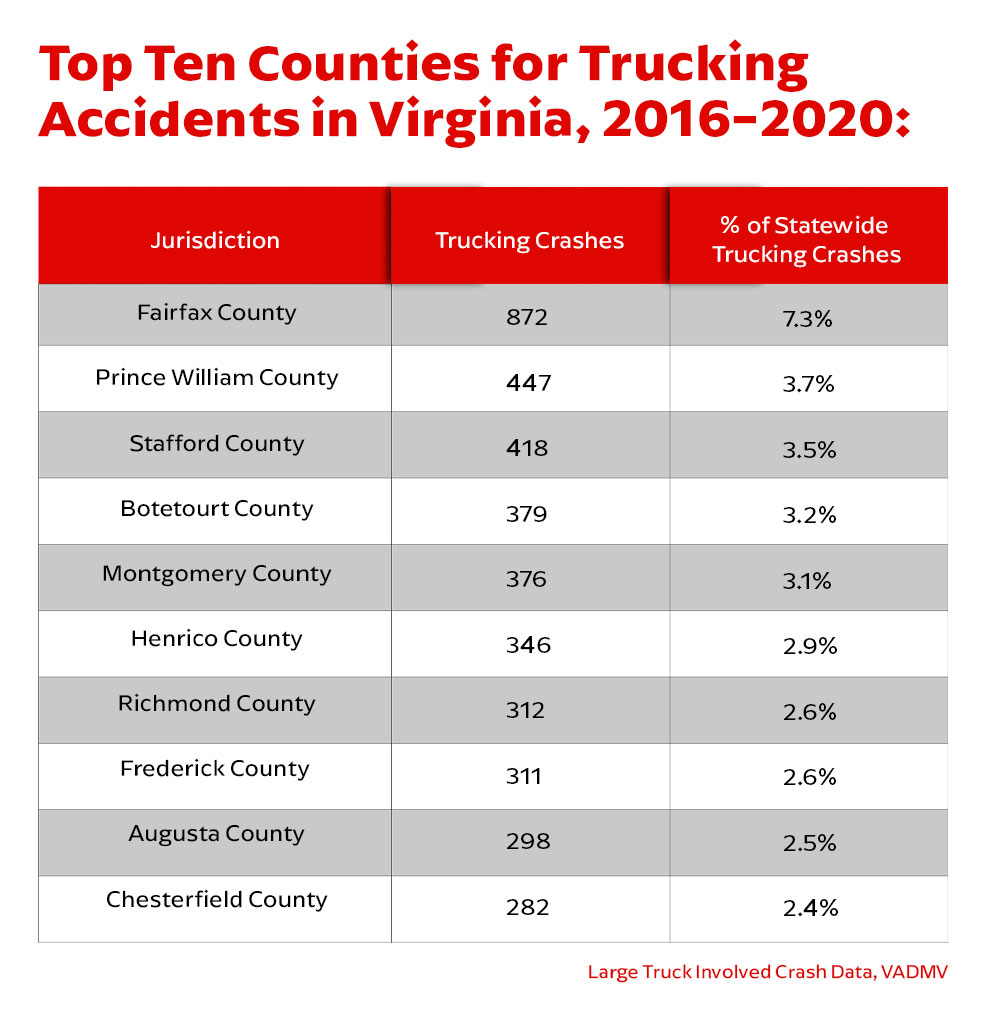
While almost no area of Virginia is unaffected by trucking accidents, there are areas where trucking accidents are more frequent.
According to the DMV’s Virginia Highway Safety Office, 73% of the jurisdictions had less than 100 large truck crashes, 21% had between 100 and 300 crashes, and 6% had over 300 crashes4. Further, “The top five jurisdictions with the most crashes accounted for 21% of all crashes from 2016-2020. The top 10 accounted for 34%4.”
Virginia Trucking Accidents in Work Zones
Work zones are particularly dangerous areas for crashes involving large trucks. According to the US Department of Transportation’s Federal Highway Administration, 30% of work zone crashes and accidents involve a large truck7.
The number of fatalities resulting from these accidents are on the rise. Between 2016 and 2018, there was an average of 206 fatal crashes in work zones involving large trucks every year8. Because these accidents often involve pedestrian construction workers, they are very dangerous.
It is important for truck drivers to take extra precautions when navigating work zones, including:
- Pay close attention to signage.
- Watch for flaggers.
- Leave plenty of room between yourself and the car ahead to avoid a crash.
- Be prepared for sudden stops or slowdowns.
- Switch lanes well in advance of lane closures.
- Watch for other drivers entering your lane.
- If possible, avoid work zones via alternate routes.
Part III: Trucking Accidents in Virginia by Time, Day, & Season
Just as it is important to recognize the patterns in trucking accident locations, it is also important for motorists to understand the times these crashes are more likely to occur. Doing so helps drivers to raise their awareness during the times, days, and seasons in which trucking accidents are most common, therefore preventing future trucking accidents.
Trucking accidents occur more frequently on the interstate during the weekends because that’s when truck drivers are more likely to make long drives, for which they would use interstates.
Trucking accidents also occur most frequently during working hours, when both more cars and trucks tend to be on the road.
Key Findings
- Trucking accidents in Virginia occur most often during working hours (9 a.m.–6 p.m.)4.
- Fewer than 10% of trucking accidents in Virginia occur during the weekends4.
- Trucking accidents are no more or less likely to occur in one month or season.
Trucking Accidents in Virginia by Time of Day
| Time Period | Sunday | Monday | Tuesday | Wednesday | Thursday | Friday | Saturday | Total |
|---|---|---|---|---|---|---|---|---|
| Midnight – 2:59am | 61 | 83 | 122 | 95 | 115 | 127 | 105 | 708 |
| 3:00am – 5:59am | 65 | 154 | 147 | 158 | 153 | 148 | 118 | 943 |
| 6:00am – 8:59am | 72 | 311 | 359 | 335 | 335 | 277 | 137 | 1,826 |
| 9:00am – 11:59am | 85 | 327 | 373 | 347 | 372 | 381 | 132 | 2,017 |
| Noon – 2:59pm | 150 | 359 | 400 | 393 | 401 | 405 | 147 | 2,255 |
| 3:00pm – 5:59pm | 136 | 354 | 382 | 418 | 409 | 360 | 108 | 2,167 |
| 6:00pm – 8:59pm | 105 | 208 | 216 | 217 | 193 | 172 | 86 | 1,197 |
| 9:00pm – 11:59pm | 89 | 136 | 132 | 153 | 154 | 138 | 61 | 863 |
| Total | 763 | 1,932 | 2,131 | 2,116 | 2,132 | 2,008 | 894 | 11,976 |
Trucking accidents occur in Virginia at all different times of day. However, there are certain periods of time when trucking accidents are more likely to occur. These times correlate to working hours when truck drivers (and passenger cars) are more likely to be on the road.
According to the DMV’s Virginia Highway Safety Office, most crashes occurred during the workweek between the hours of 9 a.m. and 6 p.m.4 Of the 11,976 trucking crashes that occurred in Virginia from 2016–2020, 6,439 occurred during this nine-hour span of time.4
It is also notable that one of the leading causes of trucking accidents is exhaustion, which may contribute to the still considerable number of accidents that occur between 6 p.m. and 9 a.m.
Trucking Accidents in Virginia by Day of the Week
When analyzing the number of trucking accidents in Virginia by the day of the week, a trend is immediately evident: Trucking accidents occur more frequently on weekdays than weekends.
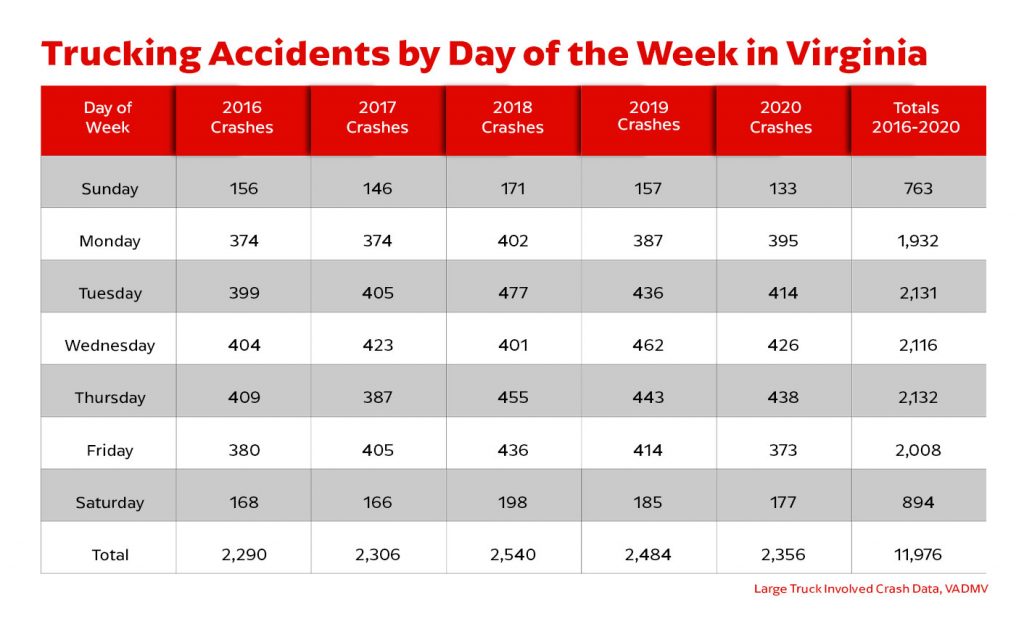
This is because on weekdays, truck drivers are more likely to be on the road, driving between destinations and making deliveries. Weekdays are also more popular days for passenger cars to be on the road, commuting to and from work. Between 2016 and 2020, weekends accounted for less than 10% of trucking accidents in Virginia.4
Trucking Accidents in Virginia by Month and Season
Between 2016 and 2020, trucking accidents occurred slightly more often in the second half of the year than in the first half of the year. Crashes also increased marginally in November and December, which could correlate with an increase in holiday shopping and shipping during those months, which increases the likelihood of large trucks on the road.
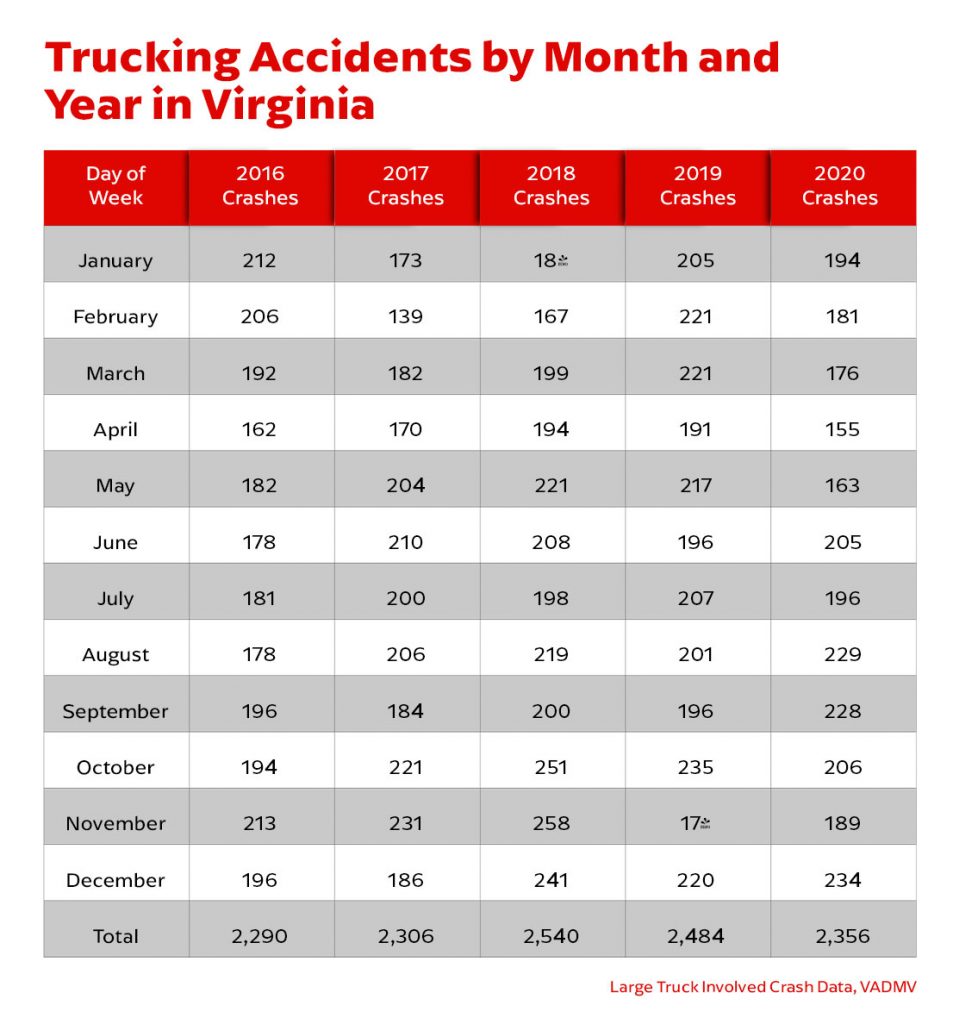
While it might be expected that wintery weather might increase the likelihood of a truck accident, that does not appear to be the case. In fact, according to the DMV’s Virginia Highway Safety Office, “Most crashes occurred without any adverse weather conditions.4”
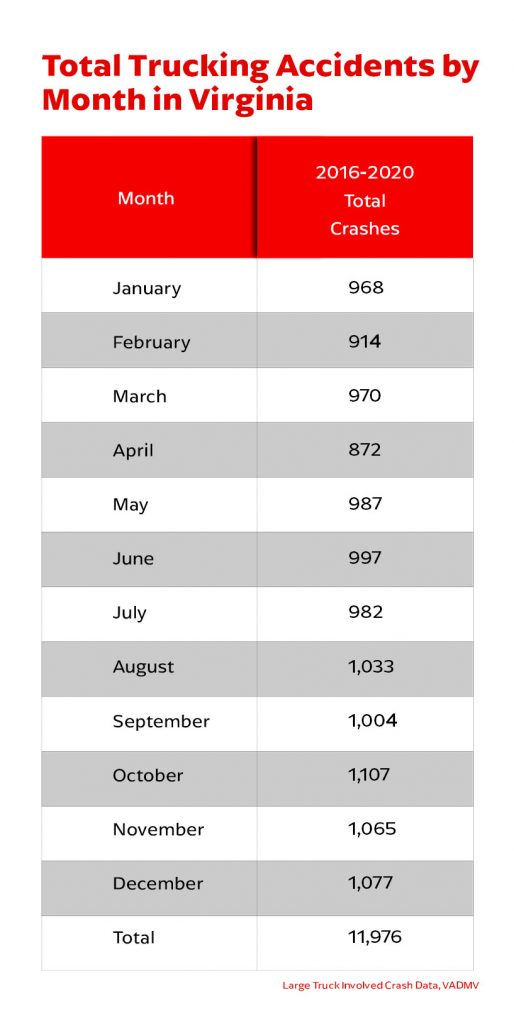
Part IV: Causes of Trucking Accidents in Virginia
There are numerous causes of trucking accidents in Virginia, from manufacturing errors to road conditions, but the most common causes are less measurable: “In terms of trucking crashes, it’s a lot like any other type of crash, it’s mostly human error (not always on the part of the truck driver),” says Eric Teoh of the Insurance Institute for Highway Safety.
According to the DMV’s Virginia Highway Safety Office, between 2016 and 2020, of the 12,775 large truck drivers involved in a crash, 48% of those drivers had an improper driver’s action which contributed to the crash4. Similarly, of the 10,736 other vehicle drivers involved in a trucking crash, 47% of those drivers had an improper driver’s action which contributed to the crash4.
While human factors may account for the majority of trucking accidents, there are many risk factors that are out of drivers’ control. These include environmental factors, such as road conditions or weather, manufacturing or maintenance issues, such as faulty brakes or tire defects, and problems with cargo.
Key Findings
- Human factors—such as speeding, unsafe lane changes, and following too close—are the most common causes of trucking crashes caused by both large truck drivers and passenger vehicle drivers.
- Speeding is particularly high risk and is the most common risk factor by both truck and passenger vehicle drivers.
- Nationally, distracted driving caused 3,142 fatalities in 2019 alone.
- Manufacturing or maintenance issues are also a high risk for truck drivers. Faulty brakes were 170% more likely to be identified as the critical reason for a crash compared to a truck that was not identified as having brake problems.
Human Factors in Trucking Accidents in Virginia
Speeding
Speeding is on the rise, and it’s contributing to more accidents, including trucking crashes.
“Another trend that’s of concern […] is a big increase in speeding as traffic volumes went down and have stayed somewhat lower,” says Teoh, speaking to early data from 2020 and 2021. “For everybody, speeding is just bad news in terms of safety.”
In a 2006 study from the US Department of Transportation’s National Highway Traffic Safety Administration (NHTSA), it was found that traveling in the same lane at a higher speed was the cause of multi-vehicle accidents for 39% of truck drivers and 50% of other vehicle drivers.9
The Federal Motor Carrier Safety Administration also indicated in its 2018 study that “Speeding of Any Kind” was the most common driver-related risk factor for drivers of both trucks and passenger vehicles involved in accidents.2 Data across a variety of different national and Virginia studies and sources indicate speeding is one of the most dangerous risk factors for all types of drivers.
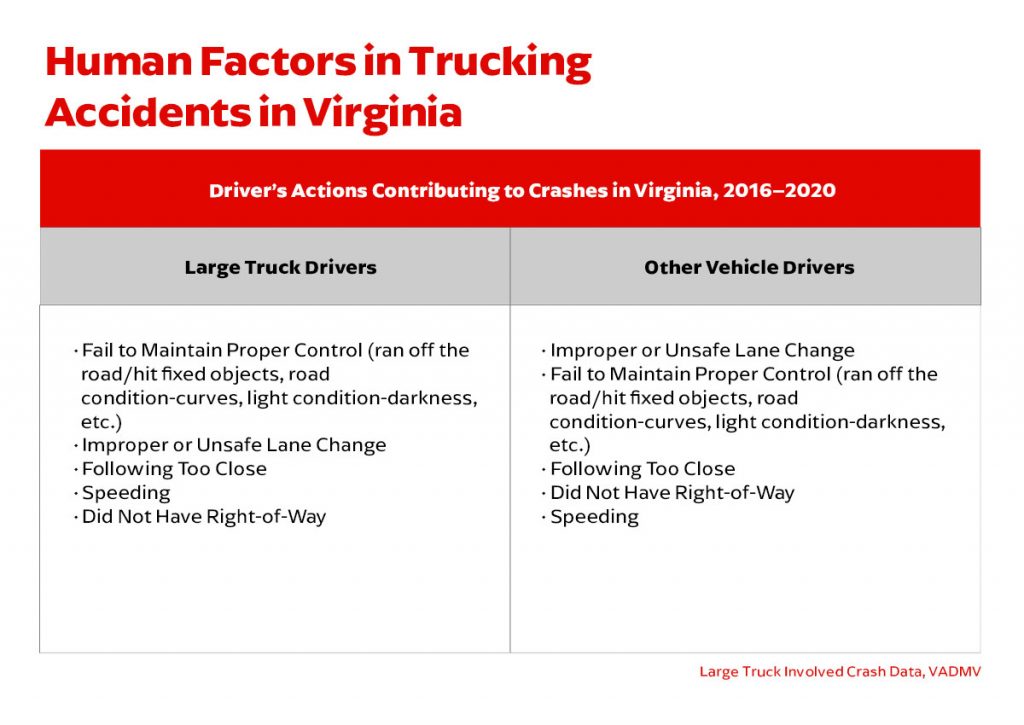
Distracted Driving
According to the Federal Motor Carrier Safety Administration’s 2018 Large Truck and Bus Crash Facts, “Distraction/Inattention” was the second most common risk factor in truck drivers.2 The National Highway Traffic Administration reports that distracted driving caused 3,142 fatalities in 2019 alone.10
Distracted driving might include using a cell phone, eating, utilizing navigation or stereo equipment, or simply not paying attention.
Texting, for example, distracts drivers for an average of five seconds. If the driver is traveling at 55 miles per hour, that’s the equivalent of driving the length of a football field without looking at the road.
It’s vital that both truck drivers and passenger car drivers prioritize driving over other activities.
Exhaustion/Impairment
The Federal Motor Carrier Safety Administration, in its 2018 Large Truck and Bus Crash Facts, indicates that “Impairment (Fatigue, Alcohol, Illness, etc.)” was the second most common risk factor in passenger vehicle drivers.2
Because truck drivers often work long hours, and many are prompted to work overtime, exhaustion is also a common risk factor among these drivers. According to the FMCSA’s The Large Truck Crash Causation Study, between April 2001 and December 2003, truck driver fatigue was a contributing cause to 18,000 accidents, 13% of such crashes in that time period.11
Aggressive Driving
In the NHTSA’s Large-Truck Crash Causation Study, aggressive driving was a cause in 1,822 accidents (1,019 truck drivers and 803 other vehicle drivers).9 This kind of driving occurs when the driver commits traffic violations as a result of their emotions, endangering others. When truck drivers drive aggressively, it is particularly dangerous because of the large weight and size of their vehicles.
Environmental Factors in Trucking Accidents in Virginia
Weather
According to the DMV’s Virginia Highway Safety Office, the majority of trucking crashes in Virginia between 2016 and 2020—81%—occurred at a time without adverse weather conditions.4 However, adverse weather conditions were present in 2,286 crashes during this time period.
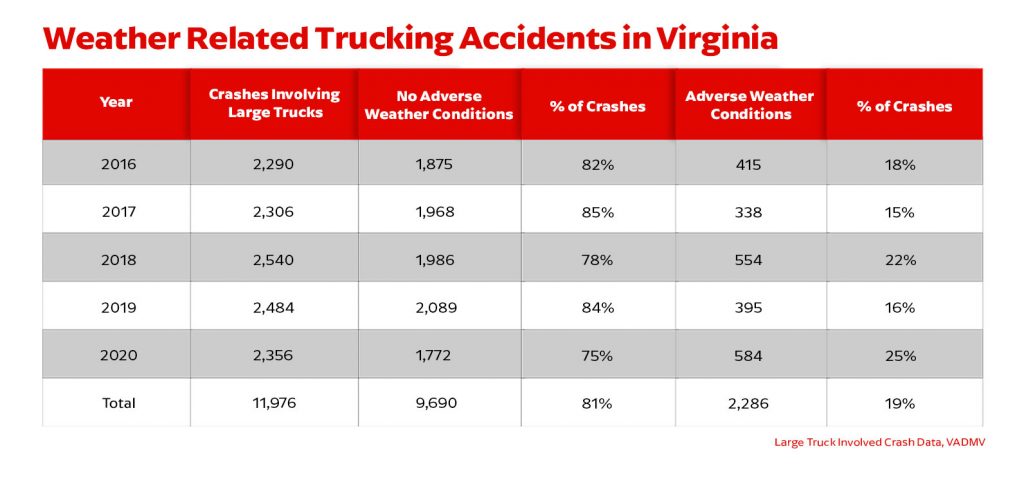
A variety of weather conditions can affect the driving of a large truck. Strong crosswinds can cause a truck to sway or cross lanes. Fog obscures truck drivers’ vision, which can be particularly dangerous because it takes them longer to slow down when braking. Rain, snow, sleet, or hail can cause truck tires to lose traction.
A 2019 study found that any precipitation increases the risk of a fatal car crash by 34%.12 Although bad weather is not always a factor in trucking accidents, it is a dangerous risk factor of which all drivers should be aware.
Road Conditions
Losing control of the vehicle is a common cause of trucking accidents. One factor that can cause a driver to lose control of his truck is the road’s condition. This could include potholes, standing water, ice, broken pavement, frost heaves (bumps in the road caused by the freezing and thawing of water in the road), or objects in the road. The NHTSA’s report found that this was a factor in some 4% of the accidents they studied.9
Construction
Construction zones are dangerous areas for drivers and workers alike. With congested traffic patterns, lane closures and changes, frequent changes in speed limiting (especially decreased speed limits), narrow roads, and workers entering the roadway, there are many risk factors that could lead to a trucking accident in these areas.
These factors are exacerbated for large trucks, which take more time to slow down, need more time to change lanes, and are difficult to navigate through narrow lanes. That is why some 30% of construction zone accidents involve a large truck.7
Traffic Flow & Congestion
The FMCSA found that congestion was one of the top ten causes of trucking accidents in their Large Truck Causation Study.11 If an accident leads to congestion, it could also leave dangerous debris or close a lane, which could cause another accident. These incidents may also distract other drivers on the road, which can affect the quality of their driving and therefore increase the likelihood of an accident. Any changes in traffic can cause accidents for passengers and truck drivers alike.
Vehicle Design & Maintenance Factors in Trucking Accidents in Virginia
Brake Problems
Even when truck brakes are in optimal condition, it takes trucks 20% to 40% further to come to a full stop than cars. That percentage only increases in adverse weather conditions. When brakes are not well-maintained, then the space it takes to stop a truck is even more dangerous.
The Large Truck Causation Study found that brakes malfunctioning was one of the top ten causes of large trucking accidents.11 The same study also found that a truck with faulty brakes was 170% more likely to be identified as the critical reason for a crash compared to a truck that was not identified as having brake problems.
Tire Defects
In the FMCSA’s report, 8,000 trucks attributed their accidents to tire problems.11 Tire problems were also the most common vehicle-related issue for passenger vehicles.2
Tire blowouts are particularly dangerous critical events in trucking accidents. Unlike a flat tire, a tire blowout is not gradual and easy to address. Tire blowouts occur when a truck tire suddenly ruptures or bursts. When these events occur, a truck driver can quickly lose control of his vehicle. The shredded tire can also fly into the path of other drivers, causing accidents.
Improper Maintenance
It is recommended that trucks receive maintenance every 10,000 to 20,000 miles. This helps prevent some of the physical defects described above that can lead to accidents. Drivers are also required to fill out a daily post-trip inspection report and note any defects. The motor carrier or agent is then required to certify that the defect has been fixed. When these regular maintenance and inspection protocols are not met, the driver endangers others on the road, leading to accidents.
Manufacturing or Design Defects
Trucks are complex and heavy machines, and when they are not properly designed, it can result in dire consequences. There are a number of manufacturing or design errors that can lead to accidents. Some of these might include brake defects, substandard tires, steering column problems, and engine and transmission defects. If these problems are present in trucks when they hit the road, they can cause accidents that endanger the truck driver and surrounding passenger cars.
Cargo
A truck’s cargo can be responsible for trucking crashes. If the cargo shifts during the drive, it can cause a dangerous imbalance in the truck that can cause accidents. According to the FMCSA, this occurred in some 4% of crashes in their study.11 Overloading or the improper loading of cargo can cause similar repercussions. These cargo problems often cause the truck to roll over. According to the IIHS, 47% of large truck occupant deaths occurred when the truck rolled over.6
Finally, hazardous cargo can be particularly dangerous if an accident occurs. Explosives, gasses, hazardous liquids, poisons, and other dangerous cargo can cause serious damage if the truck is involved in an accident.
Part V: Results and Injuries
The DMV’s Virginia Highway Safety Office reports that, between 2016 and 2020, “276 people were killed and 5,986 injured in large truck-involved crashes.”4
“Large trucks are huge, so injuries do tend to be more severe or fatal,” Teoh of the IIHS says. “A lot of times, when a truck is involved in a fatal crash, it’s not the truck driver or occupant that’s killed.” Drivers and passengers in other vehicles are vulnerable because trucks usually weigh 20 to 30 times as much as a passenger vehicle.
A particularly dangerous type of accident is an underride accident, or when a passenger car drives under a truck.
“If you go under the truck, you’re not allowing those energy absorbing structures of the car to do their job. And then, even worse, you’re often colliding with the truck at the level of the windshield, which can result in horrific injuries, including decapitation,” Teoh says.
If those in passenger cars are lucky enough to survive a trucking accident, the sheer size of the truck is still likely to cause serious injuries. It may take thousands and thousands of dollars of medical treatment and rehabilitation for these victims to recover. Their injuries may also prevent them from returning to work or their normal, day-to-day life.
Common Trucking Accident Injuries
Depending on the severity of the trucking crash, truck drivers and those in passenger vehicles alike can experience injuries that are debilitating and life-changing. Common trucking accident injuries include:
- Broken bones
- Lacerations
- Back and neck injuries, such as whiplash
- Internal injuries
- Rib and torso injuries
- Paralysis
- Traumatic brain injuries
The Emotional and Mental Repercussions of a Trucking Accident
If you or a loved one were involved in a trucking accident, the physical results of the accident will likely be your priority. However, there are long-term mental and emotional repercussions to consider.
In many cases, victims of trucking accidents are not able to return to work while they recover, if ever. In this case, they will need to account for the wages lost during their recovery. Many victims also experience emotional and mental pain and suffering after their accidents, including depression or PTSD.
Part VI: Preventing Trucking Accidents in Virginia
Trucking accidents occur in Virginia every day for a variety of reasons. Sometimes the truck driver is at fault, at other times the passenger vehicle driver, and at other times a third party, such as a manufacturer, is to blame.
With so many potentially liable parties and circumstances, the prevention of trucking crashes may seem impossible. However, by raising awareness for all parties on the road and the role they could potentially play in these accidents, we can substantially minimize the risk of trucking accidents in Virginia.
Trucking Accident Prevention for Passenger Vehicles
- Give big trucks ample space. When following behind a large truck, always make sure there’s plenty of room between you and the truck to stop safely if traffic slows. When merging in front of a truck, make sure there’s plenty of room between you and the other vehicle. And when they’re turning, remember that trucks need more clearance than cars, and give them the space to turn safely.
- Be aware of trucks’ blind spots. Trucks have larger blind spots, especially on their passenger side, so you should always pass trucks on the left. If you can’t see the truck driver’s face in their mirrors, they can’t see you, so operate carefully around them.
- Don’t drive distracted. This is a key rule for all drivers. Whether you’re texting, tired, or changing the radio station, the time you spend not paying attention to the road is time you endanger yourself and those around you.
- Don’t speed. When asked how to prevent trucking accidents, Teoh says, “Reversing the trend in increasing speed limits and increased speeding will help everybody, including trucks and anyone that unfortunately has to collide with them.”
Trucking Accident Prevention for Truck Drivers
- Plan your route in advance. If you’re driving somewhere new, there may be hurdles along the way that your GPS doesn’t predict, such as low overpasses. By studying a map in advance, you’ll be able to best route your trip and avoid distracted driving. You should also reach out to your delivery location to see if they know of any hazards along the route, especially near your destination.
- Prioritize rest. For some drivers, when you’re coming up against a deadline or overtime, it can be easy to overwork. However, there are strict regulations regarding driving times for a reason—they help keep you and others on the road safe. Always pull over when you feel drowsy, and be sure to get plenty of rest.
- Know your truck and cargo. You should know your truck inside and out so that when something goes wrong, such as a brake or steering problem, you’ll be able to recognize the issue and act accordingly. Similarly, you should know what cargo you’re towing so that if there is an emergency, you can protect those around you—and yourself—from any situation that might involve hazardous cargo.
- Perform a pre-trip inspection every time. Before every trip, you should check out your rig to make sure it’s in top condition. That means checking brakes, steering, wipers, tires, horn, lighting, mirrors, coupling devices, and emergency equipment.
Trucking Accident Prevention for Manufacturers & Organizations
- Install side and rear underride guards. Most trucks currently use rear underride guards, which has substantially decreased the risk of serious injury in underride accidents. Requiring the installation of side underride guards could have similar positive impacts. “We did a study showing that the side underride guards could reduce injury risk by about three quarters in serious side crashes with trucks,” Teoh says.
- Invest in new tech. “There are a lot of other technologies out there, like blind spot warning, lane departure warning, and adaptive cruise control, and these have a lot of potential [for preventing trucking crashes],” says Teoh of the IIHS. “Expanding the use of automatic emergency braking, including mandating it on new trucks, [is] a very promising strategy. We just did a study showing that that’s very effective at preventing rear-end crashes by about 40%.”
- Enforce inspection regulations. “Speaking to those inspection violations, continuing our enforcement efforts is important,” Teoh says. “That’s not to say that most carriers or drivers are doing things wrong—most of them are not—but catching the ones that do do things wrong is important.”
About Breit Biniazan
As Virginia’s preeminent trucking accident law firm, Breit Biniazan understands the wide-sweeping repercussions of trucking crashes. Every year, we support clients whose lives have been altered by a trucking crash—loved ones lost, careers ruined, body and soul forever changed.
But we have also witnessed the power of knowledge and support for these trucking accident victims. We are dedicated to using the data around trucking accidents to bring justice to the lives of our clients, but we’re also dedicated to using this data to change the future of trucking in Virginia.
Together, we can understand and prevent trucking accidents in Virginia. It is our hope that this study is the first step in doing so.
References
- American Trucking Association, “New Report Finds Trucking Industry Revenues Topped $700 Billion.” 2018. https://www.trucking.org/news-insights/new-report-finds-trucking-industry-revenues-topped-700-billion
- Federal Motor Carrier Safety Administration, “Large Truck and Bus Crash Facts 2018.” 2018. https://www.fmcsa.dot.gov/safety/data-and-statistics/large-truck-and-bus-crash-facts-2018#A4
- World Health Organization, “SDG Target 3.6 Halve the number of global deaths and injuries from road traffic accidents.” 2021. https://www.who.int/data/gho/data/themes/topics/sdg-target-3_6-road-traffic-injuries
- VADMV, “Large Truck Involved Crash Data.” 2021.
- VADMV, “Virginia Interactive Crash Data Report.” 2021. https://www.treds.virginia.gov/UI/Reports/Public/InteractiveReport.aspx?ReportPath=/Interactive%20Crash%20Reports/Interactive%20Report
- Insurance Institute for Highway Safety, “Fatality Facts 2019: Large trucks.” 2019. https://www.iihs.org/topics/fatality-statistics/detail/large-trucks#comparison-of-large-truck-and-passenger-vehicle-crashes
- US Department of Transportation, Federal Highways Administration, “Trucking Safely Through Work Zones.” 2014. https://safety.fhwa.dot.gov/wz/resources/fhwasa03010/
- ARTBA Work Zone Safety Consortium, “Safe Trucking Through Work Zones.” https://www.workzonesafety.org/files/documents/training/fhwa_wz_grant/artba_truck_safety_pamphlet-2020-508.pdf
- US Department of Transportation, National Highway Traffic Safety Administration, “Large-Truck Crash Causation Study: An Initial Overview.” 2006. https://crashstats.nhtsa.dot.gov/Api/Public/ViewPublication/810646
- US Department of Transportation, National Highway Traffic Safety Administration, “Distracted Driving.” 2020. https://www.nhtsa.gov/risky-driving/distracted-driving
- US Department of Transportation, Federal Motor Carrier Safety Administration, “The Large Truck Crash Causation Study – Analysis Brief.” 2007. https://www.fmcsa.dot.gov/safety/research-and-analysis/large-truck-crash-causation-study-analysis-brief
- Scott E. Stevens, Carl J. Schreck III, Shubhayu Saha, Jesse E. Bell, and Kenneth E. Kunkel, “Precipitation and Fatal Motor Vehicle Crashes: Continental Analysis with High-Resolution Radar Data.” 2019. https://journals.ametsoc.org/view/journals/bams/100/8/bams-d-18-0001.1.xml

By Courtney Sweasy
Marketing Director

Categories:
Office Locations
Related Posts
Categories
We are personal injury attorneys
Fill out our contact form to speak to our experienced Virginia trial attorneys. Breit Biniazan has helped recover millions of dollars in cases. Learn how we can help you today.